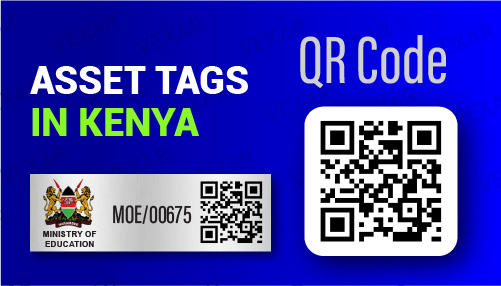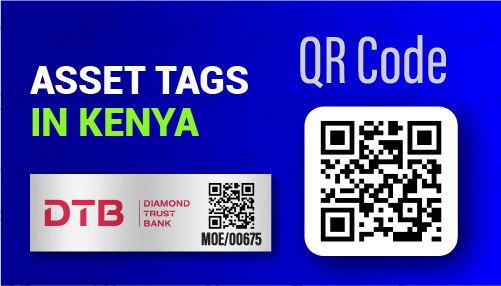Beyond Barcodes: Harnessing QR Codes with Aluminium Asset Tags


Beyond Barcodes: Harnessing QR Codes with Aluminium Asset Tags.
Unlock the efficiency of asset management with QR code asset tags. Discover the benefits of using QR codes on durable asset tags for quick and accurate asset identification, streamlined maintenance processes, and enhanced data analytics.
In today’s fast-paced and technology-driven world, asset management is becoming increasingly sophisticated and efficient. One technology that is revolutionizing asset tracking and identification is QR codes. When combined with durable aluminium asset tags, QR codes provide a powerful tool for streamlining asset management processes. Let’s explore the potential and benefits of harnessing QR codes with aluminium asset tags.
What are QR Codes?
QR codes, short for Quick Response codes, are two-dimensional barcodes that can store a vast amount of information. Unlike traditional barcodes, which can only hold a limited amount of numerical data, QR codes can store alphanumeric characters, URLs, and even multimedia content. This robust data-carrying capacity allows QR codes to provide detailed and instant information about assets.
The Power of QR Codes in Asset Management
By incorporating QR codes on durable aluminium asset tags, organizations can unlock a multitude of benefits in asset management. Here’s how QR codes revolutionize traditional asset tracking methods:
Quick and Accurate Asset Identification
QR codes can encode unique identification numbers, asset details, maintenance history, or any other relevant information about an asset. With a simple scan using a smartphone or QR code reader, users can obtain instant access to detailed information. This eliminates manual data entry, streamlines asset identification, and reduces the risk of errors. Users can quickly verify asset details or track an asset’s lifecycle with ease.
Enhanced Efficiency through Mobile Access
The integration of QR codes and mobile devices provides users with easy access to asset information anytime, anywhere. Asset managers or technicians can simply scan the QR code on an asset tag using a smartphone or tablet to instantly retrieve or update information. This eliminates the need for paper-based records or bulky laptops, resulting in improved efficiency and real-time asset management.
Maintenance and Repair Streamlining
QR codes can be utilized to streamline maintenance and repair processes. By encoding maintenance schedules, troubleshooting guides, or service history into QR codes, technicians can quickly access relevant information when servicing an asset. This enables faster response times, reduces downtime, and enhances the overall maintenance efficiency. Additionally, scanning the QR code after completing a maintenance task allows for seamless documentation and historical tracking.
Data Analytics and Reporting
QR codes enable organizations to gather valuable data and insights about their assets. By tracking QR code scans, organizations can collect information on asset utilization, frequency of maintenance tasks, and other relevant metrics. This data can then be analyzed to identify trends, predict maintenance requirements, optimize asset allocation, or generate performance reports. These insights empower organizations to make data-driven decisions and improve their asset management practices continuously.
The Power of Aluminium Asset Tags
When combined with aluminium asset tags, QR codes become even more powerful. Aluminium asset tags are known for their durability, resistance to harsh environments, and long lifespan. They can withstand exposure to extreme temperatures, chemicals, and physical stress without fading or deteriorating. This ensures that QR codes on aluminium asset tags remain readable and functional for extended periods, providing long-term benefits in asset management.
Moreover, aluminium asset tags can be customized with QR codes, logos, or other information, making them versatile and compatible with existing asset tracking systems. They can be securely attached to various surfaces, including equipment, tools, or inventory, ensuring easy scanning and identification. The combination of QR codes and aluminium asset tags creates a seamless and effective asset tracking solution that maximizes efficiency and productivity.
Benefits of QR Code Asset Tags
Efficient asset management is a critical aspect of organizational success. With the advancement of technology, traditional asset tracking methods are being replaced by more efficient and streamlined solutions. One such solution is QR code asset tags. QR codes, when combined with asset tags, provide numerous benefits that can revolutionize asset management processes. Let’s explore the advantages of using QR code asset tags.
Quick and Accurate Asset Identification
QR codes on asset tags allow for quick and accurate asset identification. With a simple scan using a smartphone or QR code reader, users can instantly access detailed information about an asset. This eliminates the need for manual data entry or searching through records, saving valuable time and effort. Asset details such as item name, serial number, location, maintenance history, or any other relevant information can be conveniently accessed, ensuring efficient asset tracking.
Streamlined Maintenance Processes
Maintenance and servicing of assets are crucial for ensuring their optimal performance and longevity. QR code asset tags simplify maintenance processes by providing easy access to maintenance manuals, troubleshooting guides, or service history. Technicians can scan the QR code on the asset tag to retrieve relevant information, eliminating the need for carrying physical manuals or searching online. This streamlines the maintenance process, reduces downtime, and ensures faster and more efficient servicing.
Enhanced Data Analytics
QR code asset tags enable organizations to gather valuable data and insights about their assets. By tracking the QR code scans, organizations can collect information such as asset utilization, maintenance frequency, or repair history. This data can be analyzed to identify patterns, optimize asset allocation, predict maintenance requirements, or generate performance reports. With access to accurate and comprehensive data, organizations can make informed decisions, improve asset management practices, and maximize efficiency.
Improved Accuracy and Reduction of Human Errors
Traditional asset tracking methods, such as manual data entry or handwritten records, are prone to errors and inconsistencies. QR code asset tags eliminate the risk of human errors by providing accurate and standardized asset information. With a simple scan, users can ensure that they are accessing the correct asset details. This accuracy not only saves time but also reduces the potential for data entry errors, ensuring that asset records are reliable and up to date.
Increased Mobility and Accessibility
QR code asset tags leverage the power of mobile technology, providing increased mobility and accessibility. Asset information can be accessed on the go, anytime and anywhere, using smartphones or tablets. This allows asset managers or technicians to retrieve or update asset information in real-time, without the need for bulky laptops or paper-based records. The ability to access asset information on mobile devices enhances productivity, enables seamless collaboration, and ensures that asset management processes can be efficiently carried out on-site.
Cost and Time Savings
Implementing QR code asset tags can lead to significant cost and time savings. The streamlined asset identification and maintenance processes reduce labor costs by minimizing manual data entry and eliminating the need for physical documents. With accurate and accessible data, asset management tasks are completed more efficiently, saving valuable time and increasing productivity. Moreover, the reduction in human errors prevents costly mistakes that may result in unnecessary expenses or asset downtime.
Conclusion
QR code asset tags offer a multitude of benefits that can greatly improve asset management processes. From quick and accurate asset identification to streamlined maintenance processes and enhanced data analytics, QR code asset tags enhance efficiency, accuracy, and accessibility. By implementing QR code asset tags, organizations can optimize their asset management practices, save time and costs, and ultimately improve their overall productivity and operational success.
QR codes have transformed the asset management landscape by providing quick access to detailed asset information and streamlining processes. When paired with durable aluminium asset tags, QR codes become even more powerful. The combination of these technologies enables organizations to streamline asset identification, enhance maintenance efficiency, gather valuable data insights, and improve overall asset management practices. By harnessing QR codes with aluminium asset tags, organizations can elevate their asset management to new heights of efficiency and control.

